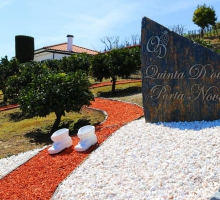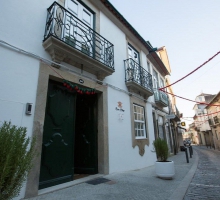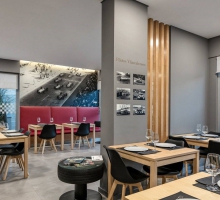The time travel is made wandering spaces and territories with identity. Each region has its own characteristics that give them this identity. It is this set of elements, natural or humanized, that make people take pride from their "land".
Now, there was about 50 years that, in the place of Ponte, between the parishes of Louredo and Fornelos, where have emerged the first traces of what at the time was called a "factory with chimney." This memory was kept in the oral tradition until about 30 years later, Father Manuel Tuna has recovered it and started a process of study and appreciation of this monument. Thus, in 1980, together with Armando Coelho da Silva and António Baptista Lopes, Manuel Tuna developed archaeological works allowing to put uncovered the remains of an oven from the Roman era. During the archaeological excavation were collected some pieces that made the authors of the papers put the hypothesis of whether it is an oven that was used to bake building ceramics: tiles and bricks.
So the public, visiting this monument with two thousand years have to imagine a scenario with people working in an oven where over the grid would be tiles and bricks to bake. Let us remember that we are in an area of excellent “Barreiros” (person who makes clay) certified by the name of the adjoining people - Barreiro. On the other hand, we must not forget that the Romans needed a huge amount of building material for their homes, temples, baths, etc. The tile was one of many technological innovations that the Romans brought to the Iberian Peninsula. Until then, the houses were covered with branches and thatch, less hot and more humid.
Concerned with the progressive deterioration of the monument, the municipality of Santa Marta de Penaguião invited the ArqueoHoje company, to implement a project of conservation and enhancement of this unique monument.
The main objective of conservation and restoration work carried out in 2005 was the structural consolidation of the Roman furnace, which was in an advanced state of degradation.
Thus, the interventions made consisted of detailed cleaning of accumulated land deposits, spot consolidation of the ceramic and stone material, filling joints and gaps with materials compatible with the originals, treatment and consolidation of the upper grid, and specific reintegration of ceramic material.
The experiments carried out in the preservation and presentation of archaeological sites show that conservation and restoration are not eternal measures, since the degradation is an evolving dynamic process. Thus, part of the success of the actions goes through a continuous maintenance of the sites, essential to its recovery.
Composition of the Oven:
The ceramic oven of Louredo was composed of a heating area buried in native soil - the oven mouth serving as a place of introduction of firewood and air circulation regulator, furnace with channel aspect where it light the bonfire and heating chamber holding the grille and simultaneously allowing a better heat distribution - and a cooking chamber - perforated grid in terracotta, on which were placed the products to baking, being surmounted by a dome with chimney for evacuating the gases and fumes.
Oven operation:
Its operation mode obeyed the following times:
1st - Inserting the previously molded pieces on the grid.
2nd - Wood combustion placed in the furnace.
3rd - After combustion, and having the furnace reached a high temperature (± 1000 degrees), the entire set was sealed with clay and thus would remain for several days until the furnace cooled.
4th - Removal of the clays and sealing of the produced parts, followed by the oven cleaning for a new production.
Location: Santa Marta de Penaguião
Now, there was about 50 years that, in the place of Ponte, between the parishes of Louredo and Fornelos, where have emerged the first traces of what at the time was called a "factory with chimney." This memory was kept in the oral tradition until about 30 years later, Father Manuel Tuna has recovered it and started a process of study and appreciation of this monument. Thus, in 1980, together with Armando Coelho da Silva and António Baptista Lopes, Manuel Tuna developed archaeological works allowing to put uncovered the remains of an oven from the Roman era. During the archaeological excavation were collected some pieces that made the authors of the papers put the hypothesis of whether it is an oven that was used to bake building ceramics: tiles and bricks.
So the public, visiting this monument with two thousand years have to imagine a scenario with people working in an oven where over the grid would be tiles and bricks to bake. Let us remember that we are in an area of excellent “Barreiros” (person who makes clay) certified by the name of the adjoining people - Barreiro. On the other hand, we must not forget that the Romans needed a huge amount of building material for their homes, temples, baths, etc. The tile was one of many technological innovations that the Romans brought to the Iberian Peninsula. Until then, the houses were covered with branches and thatch, less hot and more humid.
Concerned with the progressive deterioration of the monument, the municipality of Santa Marta de Penaguião invited the ArqueoHoje company, to implement a project of conservation and enhancement of this unique monument.
The main objective of conservation and restoration work carried out in 2005 was the structural consolidation of the Roman furnace, which was in an advanced state of degradation.
Thus, the interventions made consisted of detailed cleaning of accumulated land deposits, spot consolidation of the ceramic and stone material, filling joints and gaps with materials compatible with the originals, treatment and consolidation of the upper grid, and specific reintegration of ceramic material.
The experiments carried out in the preservation and presentation of archaeological sites show that conservation and restoration are not eternal measures, since the degradation is an evolving dynamic process. Thus, part of the success of the actions goes through a continuous maintenance of the sites, essential to its recovery.
Composition of the Oven:
The ceramic oven of Louredo was composed of a heating area buried in native soil - the oven mouth serving as a place of introduction of firewood and air circulation regulator, furnace with channel aspect where it light the bonfire and heating chamber holding the grille and simultaneously allowing a better heat distribution - and a cooking chamber - perforated grid in terracotta, on which were placed the products to baking, being surmounted by a dome with chimney for evacuating the gases and fumes.
Oven operation:
Its operation mode obeyed the following times:
1st - Inserting the previously molded pieces on the grid.
2nd - Wood combustion placed in the furnace.
3rd - After combustion, and having the furnace reached a high temperature (± 1000 degrees), the entire set was sealed with clay and thus would remain for several days until the furnace cooled.
4th - Removal of the clays and sealing of the produced parts, followed by the oven cleaning for a new production.
Location: Santa Marta de Penaguião





